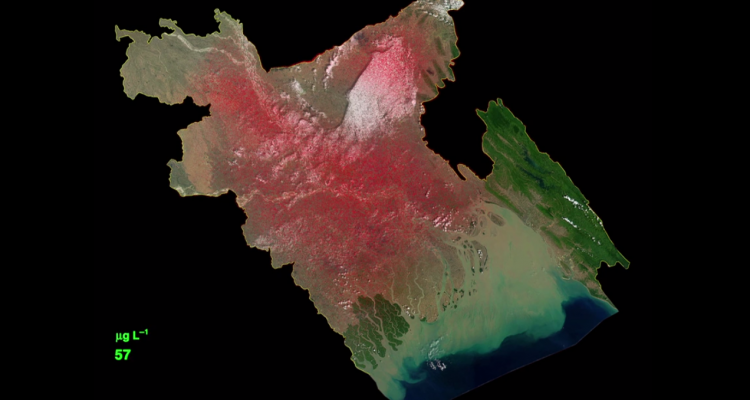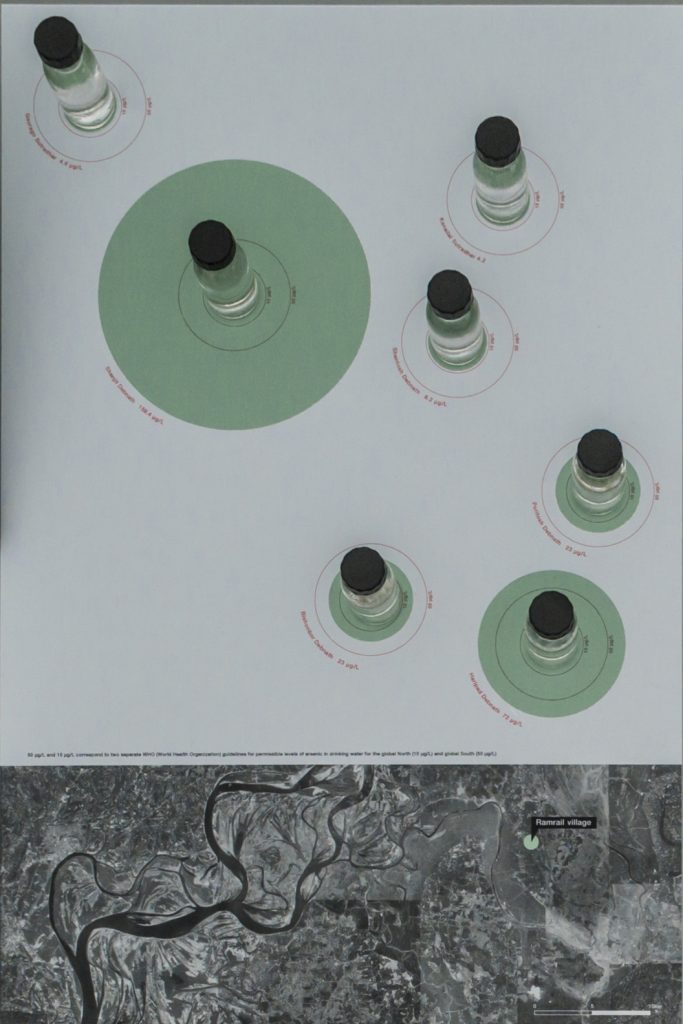 Bangladesh arsenic map: Territorial scale. Animation still. Nabil Ahmed, 2014.
Bangladesh arsenic map: Territorial scale. Animation still. Nabil Ahmed, 2014.
Ecological crises such as capital-induced climate change are one of the most important challenges for the contemporary world. In order to challenge such a catastrophic eco-political trajectory, certain assumptions about the institutions that govern us must be recomposed. What lessons can environmentalism and ecological activism learn from the field of Science & Technology Studies (STS), which has been at the forefront of the structural critique of science and law and their claims of objectivity? As Sheila Jasaonff, one of STS’s leading figures tells us, we are already there, living in a “law-like” world shaped by climate change itself, where science ethics, environmental concerns and image production intersect.
Nabil Ahmed: I want to ask you first about the two terms “co-production” and “asymmetry.” You helped develop the term co-production, a major contribution in the development of the discipline of Science and Technology Studies (STS). How do you see the interaction between the two terms? How do they work together or productively contradict each other?
Sheila Jasanoff: Let me begin with co-production. It refers to the joint emergence of the cognitive, systemic, material worlds, as we know them and what those worlds ought to be like, ought to be about. As you know, in philosophy, these worlds are and have been separated for such a long time that when it comes to modern and technological orders, we develop worldviews in which we have moral and normative investments. In that sense co-production is a technical term in Science and Technology Studies, while I don’t think asymmetry is a technical term. It simply refers to an empirical state of affairs, but again, I think that I use the term in a way that echos within STS. Methodologically, STS scholars tend to assume that the world is flat and explain how a particular ordering comes about. I think that the world is never flat and to some degree, I use asymmetries to point out to the fact that things actually don’t flow, move or occur in the world without a previously landscaped state of play. In my theoretical project, I argue that landscaping or topography is institutional. Because I am a lawyer by training I talk a fair amount about law as a grounding institution. And by now, after thirty, almost forty years of critical studies, it is well known that legal systems encode within them prior assumptions about the world; for instance one of the prevalent ideas of American law is that the market is a natural way of ordering things, therefore you should do things that help the market function the way it should – but that doesn’t have to be a prior background assumption. Asymmetries are a way of getting into those backgrounds, to try to point out where blockages exist, where people don’t in fact have those level playing fields, which, from an egalitarian perspective, they want to create.
NA: Using asymmetry as a starting point I want to ask you about the neutrality of techno-science. Let’s take the example of multinational companies, i.e. those involved in technology transfers from the global north to the south. How do you understand a legal landscape where governments or companies that engage in technology transfers are ethically responsible? For me this has a resonance to the case of widespread arsenic poisoning in Bangladesh, set off by the attempt of UNICEF and the fledgling Bangladeshi state to provide safe drinking water to rural populations by introducing deep tube wells in the early 1970s. It was not known at the time, but groundwater in Bangladesh and West Bengal has high concentrations of arsenic at least up to a depth of 100 meters. UNICEF, which initiated the program, could be held responsible for introducing a public health technology without carrying out correct risk assessments. As I have shown other actors were also implicated. In fact Bangladeshi activists and a UK-based law firm took British geologists from the National Environment Research Council to court in a ‘toxic tort’ case of negligence for failing to carry out an industry standard measure to test for arsenic in drinking water during a pilot project in the mid-1990’s. This report was used in drawing up a national water policy at the time. While thinking through this story, your edited book Learning from Disaster: Risk Management after Bhopal (University of Pennsylvania Press 1994) was instructive for me; in it, you try to understand this very precise problem that technology transfer isn’t about transferring only technology but carries with it a whole range of associated practices that, like in the case of the Bhopal chemical plant disaster in India, can lead to asymmetries of legal redress. Methodologically then how is STS a useful analytic tool to understand science as an embedded social practice, in so far as it is a social construction?

Water samples from Sutradhar’s village where British geologists had failed to test for arsenic in well waters and their arsenic contamination as graphic representation. 50 μg/L and 10 μg/L indicate two separate WHO guidelines of permissible levels of arsenic in drinking water for the global north (50 μg/L) and global south (10 μg/L). Nabil Ahmed, 2014.
SJ: Constructivism for STS means simply a kind of heightened attentiveness to the way things are put together in the world in order to destabilize what seems otherwise natural and taken for granted. In talking about Bhopal explicitly, nobody else brought up the point I was making that manufacturing process flowed from America to India as an example of technology transfer.
Everybody takes for granted that the more highly developed country will export its knowledge and know-how to the less developed one. Now a basic assumption of STS is that the transfer of technological systems comes with both the transfer of assumptions about society as well as assumptions about materiality. A very obvious point is that Union Carbide’s American factory was located in a part of the country that’s actually called Chemical Valley because there are so many chemical plants there. The workers in those plants who have worked for generations in chemical factories understand the risks and know how to operate them. So a technology develops with assumptions as to who the workers are, what kind of training they have had, and also, proper liability systems. America has a very acute system of civil liability where anybody can sue. Now, all this gets imported to India where the entire system is radically different. International companies assumed that it was just a natural thing, a technology transfer. You have a factory in one place and you set it up in another without having the whole apparatus in place that says no, any technological system is at once social and technological. From an STS perspective, the material and the social always interweave to create a certain hybrid construct.
NA: Perhaps it’s also a question of scale. Complex causalities of arsenic in the Bengal delta or generational of victims from the Bhopal chemical plant disaster plot bodies to territories in scalar shifts from the cellular to the global. Can you say more about the scalar shifts involved in your theory of STS? How does one read such scalar shifts, particularly from the perspective of law, a field which often acts as the forum for seeking redress, compensation, accountability etc. in other words how does law respond to such spatial and temporal shifts that are sometimes outside of its own institutional space and time? This brings me to thinking about the relation between climate change and law. The former is a scientific term but that at the same time has clearly entered politics and social, cultural fields (perhaps the Anthropocene thesis is an attempt at the same nowadays). Climate change has helped make sense of the world, as we know it, even to the extent in shaping how politics and states are organized.

The hands of Mrs. Ashulata Sutradhar showing arsenic related skin keratosis. She is the wife of Mr. Binod Sutradhar, the Bangladeshi villager who was the lead claimant in the case Sutradhar v. National Environmental Research Council, the only legal case that has sought legal redress for arsenic poisoning in the country. Photo credit: Nabil Ahmed, 2014
SJ: The first thing I want to say is that in my work I always understand law with a smaller “l”, Rather than a formal, statutory law. I am talking about social dispositions that operate as if law, even though they are not exactly legal. So in relation to climate change—which is where I was talking about scalar shifts—Once you say scientifically there is a thing called climate you automatically engage in one of these scalar shifts, which I think has law-like impacts. So suddenly, we are sitting on a sidewalk in London feeling the sun going in and out, thinking about this as a phenomenon of climate change rather than as the typical inconsistencies of British weather. We are thinking, “this year has been particularly bad in England and it might be related to the overall global pattern of climate change.” As soon you are thinking on these two different scales, you are – whether you like it or not – embedded in a world-order that has law-like properties. If everything that we are doing right now is contributing in a way to climate change, then we are suddenly affecting things. Law has never thought about consequences that are millennia years away. In fact, common law has tended to say, “we have no way of speculating on the future.” For common law, we should only be concerned with what is imminent, around the corner, or has already happened. Climate change, by shifting the temporality of our imagination is making us more aware of a distended scale of responsibility, and law may respond (law in a formal sense) or not. Partly this has been what international discussions have been about. To what extent are we responsible to generations in the distant future that are going to inhabit the planet? But even before formal rules and regulations, conventions and treaties – what have you – are enacted, we are in essence in a law-like environment. We are already operating with tacit rules already in play. We are being told that our attentiveness is no longer what we used to think—what is imminent, around the corner, what has immediate impacts—but that there is a different timescale in operation and similarly one can argue about spatial scales, scales in which populations themselves are constituted. This is not a conventional understanding of law.
NA: In simple terms, you are telling us not to take things for granted, or take normative concepts like the market or rules governing national boundaries, or for that matter scientific principle as givens. That doesn’t mean that these are necessarily evil projects of modernity, in that some of these institutions, such as law or science, can and should be worked upon. In the world where STS meets law or rather emerges out of a process of co-production, the use of words and languages to bring those normative background conditions to the foreground are crucial.
SJ: It would be overly simplified to say that we should be more attentive to words because I think the method and the field are about something else. They are about ways in which our practices constitute worlds, our knowledge of worlds, they way we design and try to figure out their meaning, and also the normative assumptions in which way we operate. So the analysis of language and the analysis of words is never an end in itself; it’s a way of getting to underlying assumptions and presumptions of the way we understand scientifically and technologically the kinds of worlds we live in.
NA: Can we look at images in a similar way, as an example of world understanding or world making?
SJ: Absolutely. When I use an image of the earth, which is something I have already written about to some degree (i.e. in Earthly Politics), it’s because I think that visuality is very important. In some of my traditional legal work in which I look at legal proceedings in court, I have addressed the idea that the visual domain is an important piece of how we go about understanding relationships, norms and so forth, and there’s no question in my mind that in the digital world, visual space will become a space of what I call public reason; we are already seeing pictures doing an enormous amount of work – one picture is supposed to be worth a thousand words. To some extent, we are even witnessing a hollowing out of the verbal world, tweets taking the place of extended arguments because a picture plus a tweet can convey more information than a text. The analytics of how to deal with images as vehicles of reasoning is a developing field.

Radical Meteorology. Video still. Nabil Ahmed, 2014.
NA: I would go on to add that this way of image making, or image production, or by extension a visual culture can also be law-like. We are constantly producing images. In some cases they are acting as evidence (of human rights violations, war crimes or environmental crimes). This law-like image making is proliferating, even when not produced in the specific context of producing evidence such as remote sensing imagery.
SJ: Yes, there’s a great deal of STS work on the production of images and it’s very micro focused. It has to do with the ways in which scientists make observations about the world and render them into readable form, which is often with images. It has been pointed out in many different contexts that the image that you see is not a mirror representation of the thing that is being depicted. When you see the image of a hurricane, you sort of recognize a hurricane, but an actual hurricane doesn’t look or feel like the image, That kind of analytical work on the production of images is constantly in progress and important because it shows you where judgment is being exercised. When making an image, you can heighten the seeming intensity of the scene you are representing, you can crop it, you can adjust it. But to jump up to equate the law with the way images function, I think that you would have to do a different kind of work; that work is an open book, those pages have not yet been written.
The interview was conducted during the Roundtable seminar “Earthly Poison: Arsenic in the Bengal Delta” organized by Nabil Ahmed in 2013 at the Centre for Research Architecture, Goldsmiths, University of London.